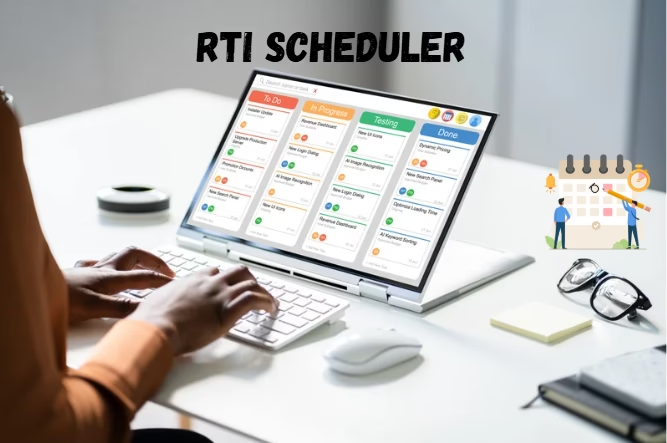Are you juggling multiple projects with tight deadlines and feeling overwhelmed? Meet your new best friend: the RTI Scheduler. This powerful tool can transform how you plan, execute, and manage tasks seamlessly. Whether you’re a project manager or part of a small team, mastering the RTI Scheduler can elevate your productivity to new heights.
Imagine having a clear roadmap for each phase of your project. With its user-friendly interface and robust features, you’ll find it easier than ever to keep everything on track. Ready to dive in? Let’s explore how to make the most out of this innovative scheduling software!
What is RTI Scheduler?
RTI Scheduler is a project management tool designed to streamline the planning and execution of tasks. It provides users with an intuitive platform for organizing workflows, setting deadlines, and tracking progress.
What sets RTI Scheduler apart is its focus on real-time updates. You can instantly see task changes or updates made by team members, ensuring everyone stays in sync. This feature fosters collaboration and keeps communication channels open.
The software also includes customizable templates that cater to various project types. Whether you’re managing a small event or overseeing a large-scale initiative, you can tailor the scheduler to fit your specific needs.
Additionally, RTI Scheduler offers integration capabilities with other tools like calendars and email platforms. This makes it easier for teams to coordinate schedules without jumping between multiple applications. Embracing this tool can significantly enhance efficiency in any work environment.
Benefits of using RTI Scheduler
Using RTI Scheduler can transform the way teams manage projects. One of its standout benefits is enhanced organization. With a centralized platform, all project details are easily accessible.
Another significant advantage is improved communication. Team members can share updates in real-time and collaborate efficiently. This leads to fewer misunderstandings and keeps everyone aligned on goals.
Time management becomes simpler with RTI Scheduler as well. The tool allows for setting deadlines and reminders, helping prevent tasks from slipping through the cracks.
Additionally, resource allocation is optimized. Teams can track who’s working on what, ensuring no one feels overwhelmed or underutilized.
The ability to generate reports provides valuable insights into project performance. Analyzing this data helps identify areas for improvement and guides future planning efforts effectively.
Step 1: Creating a Project
Creating a project in RTI Scheduler is the first step toward successful planning. Start by logging into your account and navigating to the dashboard.
Click on “Create New Project.” Here, you’ll find fields for essential details like project name, description, and start date. Filling these out helps set clear expectations from the get-go.
Once you’ve entered all pertinent information, choose a suitable template if available. Templates can streamline your setup process and offer best practices baked right in.
Don’t forget to save your progress frequently. This ensures that no valuable data gets lost as you move forward with setting up other elements of your project within the scheduler platform.
Step 2: Setting up Tasks and Deadlines
Setting up tasks and deadlines in RTI Scheduler is a crucial step for effective project management. Begin by breaking down your project into manageable tasks. Each task should have clear objectives to guide your team.
Once you’ve listed out the necessary tasks, assign realistic deadlines. Consider factors like team capacity and resource availability when setting these timelines. This helps create achievable milestones that keep everyone on track.
Utilize the platform’s features to prioritize tasks based on urgency or importance. Color-coding can aid visibility, making it easier for team members to focus on what needs immediate attention.
Don’t forget to allow some flexibility within your schedule. Unexpected challenges may arise, so having buffer time will help accommodate any delays without derailing the entire project timeline. Engaging with your team during this phase fosters collaboration and accountability as well.
Step 3: Assigning Resources and Tracking Progress
Assigning resources is crucial in the RTI Scheduler. This step ensures that every task has the right person or team behind it. You can easily allocate resources based on skill sets and availability.
Once you’ve assigned tasks, tracking progress becomes vital. The RTI Scheduler allows you to monitor each phase of your project seamlessly. Regular updates help identify bottlenecks early on.
You’ll appreciate how visual dashboards provide insights into task completion and resource utilization. These features support informed decision-making throughout your project’s lifecycle.
Communication tools within the scheduler facilitate collaboration among team members as they update their statuses and share feedback. Keeping everyone aligned enhances productivity and accountability.
Don’t forget to adjust assignments if someone is overloaded or underperforming. Flexibility is key to staying on track toward achieving your goals efficiently while using the RTI Scheduler effectively.
Step 4: Generating Reports and Analyzing Data
Generating reports within RTI Scheduler is a breeze. This tool allows you to create detailed insights into your project’s progress. You can customize the reports based on various parameters like task completion, resource utilization, and timeline adherence.
Analyzing data from these reports provides valuable feedback. It highlights bottlenecks and areas needing attention. With visual aids such as graphs and charts, understanding complex information becomes simpler.
Regularly reviewing these analytics fosters informed decision-making. You’ll spot trends that may affect future projects or identify tasks consistently falling behind schedule.
Tailoring your approach based on this analysis can lead to improved efficiency in ongoing work. Plus, sharing these findings with stakeholders enhances transparency and trust in your project management process.
Tips for Effective Use of RTI Scheduler
To maximize the potential of RTI Scheduler, start with clear project goals. Knowing what you want to achieve helps in crafting a focused plan.
Regularly update tasks and deadlines. This keeps everyone aligned and informed about any changes that may arise during the project lifecycle.
Use color-coding for different task categories or priorities. Visual aids can simplify tracking progress at a glance, making it easier for team members to stay on top of their responsibilities.
Encourage open communication among team members. Regular check-ins foster collaboration and ensure that everyone is aware of challenges or delays as they occur.
Take advantage of the reporting features within RTI Scheduler. Analyzing data allows you to spot trends, understand bottlenecks, and improve overall efficiency in future projects.
Troubleshooting Common Issues
When using RTI Scheduler, encountering issues can be frustrating but manageable. One common problem is syncing errors. If tasks aren’t appearing as expected, ensure your internet connection is stable and try refreshing the application.
Another frequent obstacle involves user permissions. Sometimes team members may struggle to access certain features or data. Double-check their assigned roles within the project settings to make sure everyone has appropriate access.
If you experience delays in task updates, clearing your browser’s cache could help. This often resolves glitches that hinder real-time progress tracking.
If reports are generating incorrectly, revisit your filter settings and criteria inputted during report creation. Making simple adjustments here usually does the trick for accurate output.
Remember that consulting customer support through official channels can provide tailored solutions when troubleshooting becomes overwhelming.
Case study: Real-life example of successful project management with RTI Scheduler
To better understand the effectiveness of RTI Scheduler, let’s explore a real-life case study.
A mid-sized marketing agency faced challenges while managing multiple client projects simultaneously. Tasks were often duplicated, deadlines frequently missed, and team members struggled to communicate efficiently. The management decided it was time for a change and implemented RTI Scheduler.
Initially, they created separate projects for each client within the software. This allowed them to visualize timelines distinctly and avoid overlap in task assignments. With clear visibility on tasks and deadlines established from the get-go, everyone was aligned right from the start.
Next came setting up tasks specific to each project along with their respective deadlines. Team leads assigned resources based on individual strengths and availability using RTI Scheduler’s intuitive interface. This ensured that no one felt overwhelmed or underutilized.
As projects progressed, tracking took center stage. Managers utilized RTI Scheduler’s progress tracking features to monitor every phase closely—identifying bottlenecks early before they could escalate into bigger issues.
The reporting function proved invaluable too; weekly updates were generated automatically showcasing various metrics like task completion rates and resource allocation efficiency. These insights guided strategic adjustments as needed so that clients continually received top-notch service without delays.
The result? By leveraging the tools available through RTI Scheduler effectively, this agency improved its overall productivity by 30%—a remarkable turnaround given their previous struggles! Communication gaps diminished significantly as teams began collaborating seamlessly around shared goals instead of working in silos.
This case illustrates how adopting an effective scheduling tool can transform not just workflows but also enhance collaboration among teams leading toward successful project outcomes over time.

